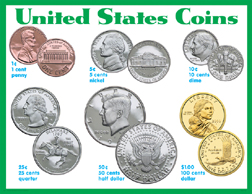Chapter 7- Determine the Value of Money
Summary
 7-1 Pennies, Nickels, and Dimes: I can skip count to find the value of a group of coins.
7-1 Pennies, Nickels, and Dimes: I can skip count to find the value of a group of coins.
Vocabulary: Cent: $0.01, 1¢, or 1 penny. Penny: one cent, $0.01, or 1¢. Nickel: $0.05, 5 cents, or 5¢. Dime: $0.10 or 1¢, or 10 cents.
7-2 Quarters and Half-Dollars: I can identify a quarter and half-dollar; skip count to find the value of a group of coins.
Vocabulary: Quarter: $0.25, 25¢, or 25 cents. Half-dollar: $0.50, 50¢, or 50 cents.
7-3 Count Coins: I can skip count to find the value of a group of coins.
7-4 PSS: Act It Out: I can use act it out as a strategy to solve problems.
7-5 Dollar: I can identify coin combinations that equal to one dollar.
Vocabulary: Dollar: $1.00, 100¢, or 100 cents. Dollar sign: a mark to indicate money ($). Decimal point: a point used in a number. Example: $2.95
7-6 Add Money: I can add money amounts.
7-7 Check Money: I can subtract money amounts.
6-8 PSS: Choose a Strategy: I can choose the best strategy to solve problems.
6-9 Estimate Differences: I can estimate differences by rounding to the nearest tens.

